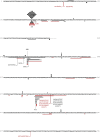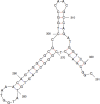Mutational Consequences of Ciprofloxacin in Escherichia coli
- PMID: 27480851
- PMCID: PMC5038312
- DOI: 10.1128/AAC.01415-16
Mutational Consequences of Ciprofloxacin in Escherichia coli
Abstract
We examined the mutagenic specificity of the widely used antibiotic ciprofloxacin (CPR), which displays weak to moderate mutagenic activity in several bacteria and generates short in-frame deletions in rpoB in Staphylococcus aureus To determine the spectrum of mutations in a system where any gene knockout would result in a recovered mutant, including frameshifts and both short and long deletions, we examined CPR-induced mutations in the thymidylate synthase-encoding thyA gene. Here, any mutation resulting in loss of thymidylate synthase activity generates trimethoprim (Trm) resistance. We found that deletions and insertions in all three reading frames predominated in the spectrum. They tend to be short deletions and cluster in two regions, one being a GC-rich region with potential extensive secondary structures. We also exploited the well-characterized rpoB-Rif(r) system in Escherichia coli to determine that cells grown in the presence of sublethal doses of CPR not only induced short in-frame deletions in rpoB, but also generated base substitution mutations resulting from induction of the SOS system. Some of the specific point mutations prominent in the spectrum of a strain that overproduces the dinB-encoded Pol IV were also present after growth in CPR. However, these mutations disappeared in CPR-treated dinB mutants, whereas the deletions remained. Moreover, CPR-induced deletions also occurred in a strain lacking all three SOS-induced polymerases. We discuss the implications of these findings for the consequences of overuse of CPR and other antibiotics.
Copyright © 2016, American Society for Microbiology. All Rights Reserved.
Figures



Similar articles
-
Overexpression of SOS genes in ciprofloxacin resistant Escherichia coli mutants.Gene. 2016 Jan 15;576(1 Pt 1):115-8. doi: 10.1016/j.gene.2015.09.069. Epub 2015 Oct 2. Gene. 2016. PMID: 26432001
-
Ciprofloxacin selects for RNA polymerase mutations with pleiotropic antibiotic resistance effects.J Antimicrob Chemother. 2017 Jan;72(1):75-84. doi: 10.1093/jac/dkw364. Epub 2016 Sep 12. J Antimicrob Chemother. 2017. PMID: 27621175
-
Antimicrobial Susceptibility and SOS-Dependent Increase in Mutation Frequency Are Impacted by Escherichia coli Topoisomerase I C-Terminal Point Mutation.Antimicrob Agents Chemother. 2015 Oct;59(10):6195-202. doi: 10.1128/AAC.00855-15. Epub 2015 Jul 27. Antimicrob Agents Chemother. 2015. PMID: 26248366 Free PMC article.
-
New approaches to combating antimicrobial drug resistance.Genome Biol. 2005;6(13):243. doi: 10.1186/gb-2005-6-13-243. Epub 2005 Dec 23. Genome Biol. 2005. PMID: 16420675 Free PMC article. Review.
-
Adaptive mutation and amplification in Escherichia coli: two pathways of genome adaptation under stress.Res Microbiol. 2004 Jun;155(5):352-9. doi: 10.1016/j.resmic.2004.01.020. Res Microbiol. 2004. PMID: 15207867 Review.
Cited by
-
Role of the SOS Response in the Generation of Antibiotic Resistance In Vivo.Antimicrob Agents Chemother. 2021 Jun 17;65(7):e0001321. doi: 10.1128/AAC.00013-21. Epub 2021 Jun 17. Antimicrob Agents Chemother. 2021. PMID: 33875437 Free PMC article.
-
RecA and Specialized Error-Prone DNA Polymerases Are Not Required for Mutagenesis and Antibiotic Resistance Induced by Fluoroquinolones in Pseudomonas aeruginosa.Antibiotics (Basel). 2022 Feb 28;11(3):325. doi: 10.3390/antibiotics11030325. Antibiotics (Basel). 2022. PMID: 35326787 Free PMC article.
-
A role for the stringent response in ciprofloxacin resistance in Pseudomonas aeruginosa.Sci Rep. 2024 Apr 13;14(1):8598. doi: 10.1038/s41598-024-59188-z. Sci Rep. 2024. PMID: 38615146 Free PMC article.
-
Psychoactive Drugs Induce the SOS Response and Shiga Toxin Production in Escherichia coli.Toxins (Basel). 2021 Jun 23;13(7):437. doi: 10.3390/toxins13070437. Toxins (Basel). 2021. PMID: 34201801 Free PMC article.
-
Rapid assembly of biofilms from DNA released by SOS-inducing drugs in enteric bacteria.Sci Rep. 2025 Apr 13;15(1):12711. doi: 10.1038/s41598-025-96943-2. Sci Rep. 2025. PMID: 40223123 Free PMC article.
References
MeSH terms
Substances
LinkOut - more resources
Full Text Sources
Other Literature Sources
Medical
Miscellaneous

